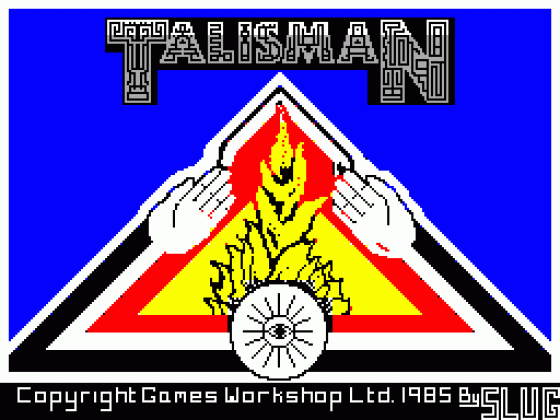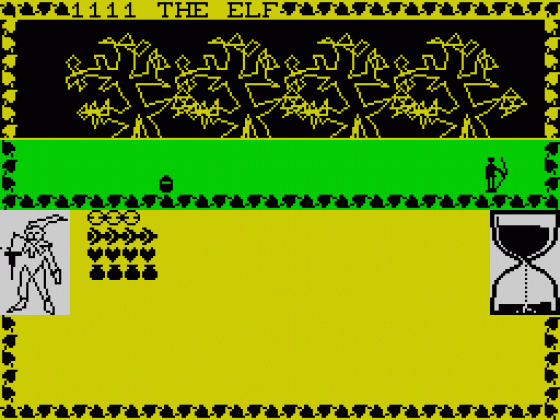
Crash
 1st May 1985
1st May 1985
Categories: Review: Software
Author: Derek Brewster
Publisher: Games Workshop
Machine: Spectrum 48K
Published in Crash #16
Talisman
Talisman is a computer development of an original board game by Robert Harris programmed by a team with the charming name of SLUG (slow, stick to their job, but leave a trail of games on their procession round the software houses)? Reading Angus Ryall's column in the October Crash I learnt that SLUG left Redshift before they let rent a new improved Apocalypse. You know, Angus, reading Crash is a much easier way to keep in touch with the industry than traipsing round trade fairs. There again, I quite like the idea of producing software as opposed to having to write it. Anyway, let's leave the in-jokes (a sign of moribund complacency) to the music press and get straight into this one.
Talisman describes itself as an interactive multiplayer arcade adventure for 1 - 4 players and the quest is to reach the Crown of Command which rests in a far off legendary place. Finding your way to the crown is made difficult by the array of magical creatures and evil forces who have plunged the land into a deep forbidding fear. Were this not enough, you must vie for the coveted crown and its glories along with your fellow players who all choose a character to represent them on their journey. Characters include an elf, priest, assassin, warrior, thief, sorceress, wizard, ghoul, druid and a troll. Up to four characters can be picked and each can either be controlled by a player or the computer. Indeed, if you wish to see how the game works, you can select four computer controlled characters, select the fastest option and sit back and watch the action - a boon for reviewers. Another way of easing your way into what is a very complex strategy game (the instructions cover five sides) is to have a trial run with just one character.
The instructions have a table which shows the attributes of your chosen character ranging from elf (strength 3, craft 4) through ghoul (4,4) to the likes of a troll (5,3). These values are significant early on when the outcome of a fight is more likely to be favourable if the relevant attribute is greater than your opponent's. If you choose fights with opponents of similar values the computer tends to err on the side of your assailant and you lose one of your precious lives.

If this review comes over a little disjointed it's because I'm writing LIVE (i.e. without a script - isn't this exciting, like The Tube!) trying to look up and see what this computer movie is up to. Right now the troll seems to be doing rather well on his own so I think I'll choose him next time, never know, SLUG may have built in an inherent bias towards the ugly, less appealing figures.
So what do you actually see on the screen? Well the design of the screen is very pleasing and attractive, so much so, I think an automatic game with four independent characters would brighten up the window display of any thoroughfare computer store. In the top half is the movie screen where all the objects, characters and action occur - and I mean action, as the figures rush and lunge at each other emanating the Arrrs and Ugs of the cartoon strip where they meet. The pictures which make up the backdrops are particularly attractive (although not logical as there is no attempt to link them into a coherent geography). The middle section of the screen is flanked down one side by a graphic depicting the character presently playing and an hour glass graphically revealing the time running out on that character's turn. Occasionally messages are relayed to the player in this area, telling of some great evil or good fortune that has fallen upon the character, or offering a choice between, say, a blacksmith's or enchantress's services. Also in the middle area comes the state of play of any fights with eitherthe craft values or strength values of both the player and his attacker displayed.
The computer rather fiendishly, chooses which attribute, craft or strength, is to be used to decide the outcome when an independent character attacks and it's infuriating to see a warrior do battle with craft rather than his innate strength. Having said this, it is not unusual for a warrior to pick up craft on his travels. When other players are in the same frame you can choose to do battle with the added impetus of being able to decide upon craft or strength. After playing for some time you might come across fights which are drawn, leaving both characters standing off each other.
To do battle or to pick up an object, you press ENTER, whereupon either an assailant appears, more or less coming straight for you, or the opportunity to pick an object or visit a blacksmith, enchantress etc appears. An object picked up is displayed on the bottom of the screen but you will have to work out what the stranger designs are for yourself from the list in the instructions as there is no link up between words and graphics anywhere. If a monster should come straight at you, a little time exists for you to make good your escape, an action which must be taken if you glance down to see your opponent's craft or strength to be any greater than your own, as otherwise it will certainly result in a lost life.
There is one other screen which can be called up, showing the status of the character currently playing. This has a summary of everything that concerns that character with an indication whether it is good, neutral or evil, which objects are carried and which followers have sworn their allegiance. The followers are the various maidens, prince and princesses needed to complete the quest; for example, it is possible to get lost lives healed at a castle when accompanied by a prince or princess. Both on the main action screen and the status screen are a set of letters which build up as play progresses These are spells with the likes of psionic blast, which concentrates your alpha waves into an unstoppable energy beam, and the time dilation,where all other players miss a turn.
Playing the game a lot suggests ways of how best to pick up craft and strength points without forfeiting a life. Moving to one side of the screen before pressing ENTER is advisable so you can see the attributes of your opponent, should one appear, before deciding whether to do battle. If a fight is inopportune you simply press the cursor key to travel into the next frame. Repeating this process can see you picking up many credits while avoiding the worst of the conflicts. Care must be taken, however, in one or two locations where you meet the end of the world. You can become trapped in the Southern Crags where you cannot move off the right hand side and forced to do battle should an assailant appear.
Talisman is a very complex strategy game with superb graphics and all the other trappings of a well designed and highly polished piece of software. Where the game really excels is in its offering entertainment for up to four players which is sufficiently complex to keep all interested for the duration. As with all involved strategy games, it will take a while to get into it, but I think the time would be well spent as this game has a lot going for it.
Comments
Difficulty: Variable levels
Graphics: Good backdrops with horizontally moving animated characters
Presentation: Very attractive
Response: Fast
Other Reviews Of The Talisman For The Spectrum 48K
Talisman (Games Workshop)
A review by T.W. (Home Computing Weekly)
Talisman (Games Workshop)
A review
The Talisman (Games Workshop)
A review by Richard Price (Sinclair User)
The Talisman (Games Workshop)
A review by Paul Coppins (C&VG)









